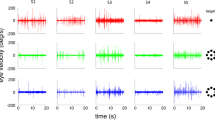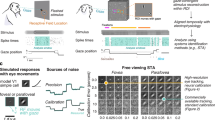Abstract
Background
The eye is moved so that the object of interest falls on the central fovea, where the spatial resolution is highest. In the present study we quantified eye movements of normal test persons during steady fixation and characterized the fixation using a 3D fixation plot (X horizontal eye position, Y vertical eye position, Z time in each eye position).
Method
Fixation eye movements were quantified binocularly in ten normal test persons during a 40-s fixation task using an infrared recording technique.
Results
The fixation plot was characterized by a single preferred fixation locus in 17 eyes. One eye had two distinctly separated preferred fixation locations and in two eyes the configuration of fixation plot was flat with no single identifiable locus of fixation. The fixation plots were elliptical along the horizontal meridian in 9 eyes, elliptical along the vertical meridian in 8 eyes, and round in 3 eyes. The fixation area (RAF95) ranged between 1418 and 14182 arcmin2, and a significant positive correlation was found between RAF95 and the mean microsaccadic amplitude (p<0.001).
Conclusion
The fixation plots are often characterized by a single preferred fixation locus but may also be almost flat with no identifiable location of fixation. The individual fixations patterns resembles the cone density contour plots as found in histological studies, and it may be speculated, that the shape of the fixation plot is determined by the cone density topography.



Similar content being viewed by others
References
Ahnelt PK, Kolb H, Pflug R (1987) Identification of a subtype of cone photoreceptor, likely to be blue sensitive, in the human retina. J Comp Neurol 255:18–34
Cornsweet TN (1956) Determination for the stimuli for involuntary drifts and saccadic eye movements. J Opt Soc Am 46:987–993
Curcio CA, Sloan KR, Packer O, Hendrickson AE, Kalina RE (1987) Distribution of cones in human and monkey retina: individual variability and radial asymetry. Science 236:579–581
Curcio CA, Sloan KR, Kalina RE, Hendrickson AE (1990) Human photorecepter topography. J Comp Neurol 292:497–523
Ditchburn RW, Foley-Fischer (1967) Assembled data in eye movements. Opt Acta 14:113–118
Ditchburn RW, Ginsborg BL (1953) Involuntary eye movements during fixation. J Physiol 119:113–118
Farber DB, Flannery JG, Lolley RN, Bok (1985) Distribution patterns of photoreceptors, proteins and cyclic nucleotides in the human retina. Invest Ophthalmol Vis Sci 26:1558–1568
Gerritz HJM, Haan B, Vendrik AJH (1966) Experiments with retinal stabilized images. Relation between the observations and neural data. Vision Res 6:143–145
Hamstra SJ, Sinha T, Hallett PE (2001) The joint contribution of saccades and ocular drifts to repeated ocular fixations. Vis Res 41:1709–1721
Jampel RA, Shi DX (2000) Retinal micromovements, the visual line, and Donders’ Law. Am J Ophthalmol 129:224–234
Kosik W, Fikre J, Sekuler R (1986) Visual fixation stability in older adults. Invest Ophthalmol Vis Sci 27:1720–1725
Kowler (1990) Reviews of oculomotor motor research volume. Eye movements and their role in visual an cognitive processes. Elsevier, Amsterdam
Møller F, Sjølie AK, Bek T (1996) Quantitative assessment of fixational eye movements by scanning laser ophthalmoscopy. Acta Ophthalmol Scand 74:578–583
Møller F, Laursen ML, Thygesen J, Sjølie AK (2001) Binocular quantification and characterization of microsaccades. Graefes Arch Clin Exp Ophthalmol 240:765–770
Nachmias (1959) Two-dimensional motion of the retinal image during monocular fixation. J Opt Soc Am 10:67–71
Ratliff F, Riggs LA (1950) Involuntary movements of the eye during monocular fixation. J Exp Psychol 40:687–701
Riggs LA; Ratliff F, Cornsweet J, Cornsweet T (1953) The disappearance of steadily fixated objects. J Opt Soc Am 43:495–501
Steinman RM (1965) Effect of target size, luminance, and colour on monocular fixation. J Opt Soc Am 5:1158–1165
Østerberg GA (1935) Topography of the layer of rod and cones in the human retina. Acta Ophthalmol 13 (Suppl 6):1–97
Author information
Authors and Affiliations
Corresponding author
Rights and permissions
About this article
Cite this article
Møller, F., Laursen, M.L. & Sjølie, A.K. Fixation topography in normal test persons. Graefe's Arch Clin Exp Ophthalmo 244, 577–582 (2006). https://doi.org/10.1007/s00417-004-0869-z
Received:
Revised:
Accepted:
Published:
Issue Date:
DOI: https://doi.org/10.1007/s00417-004-0869-z




